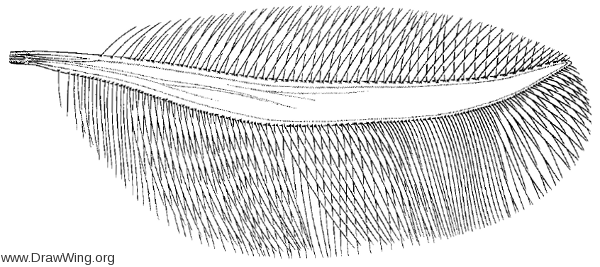 |
| Lectotype of Ornithopsis hulkei (Brachiosauridae?) |
 |
| Reconstruction of S. incredibilis (bottom) with holotype (male) above (Grimaldi & Engel, 2005) |
 |
| Mrs. and Mr. Pseudopulex wangi (Pseudopulicidae) |
| Paratype of Coonilla longictena (Ischnopsyllidae) |
A parasitic taxon uniquely occurring on pterosaurs has interesting ramifications for vertebrate paleontology, since it implies that these volant reptiles were endothermic and social (Vršanský et al., 2010). Which would be pretty darn cool—if it were true.
 |
| Reconstruction of S. daohugouensis ' natural history |
 |
| Line drawing of N. walkeri's wing (Kevan & Cutten, 1981) |
In summation, the Strashilidae were not at all ectoparasitic, despite the universal consensus for the past 21 years that they were. The lesson we can derive from of all this is that (as the Raptorex fiasco amply displayed) in paleontology, "the experts" can (and will) screw up. Repeatedly. It's not dissimilar to other professional fields—say, medicine—but paleontologists will own up to their mistakes without the prodding of litigation.
*"In the broad sense"—including the Nycteribiidae (see "Mormotomyiids' Terrible Hairiness").
†Not belonging to the suborder Brachycera: that is, their antennae have more than 3 segments and lack an arista.
‡ Muscular extensions of the abdomens of some insect larvae, which act as legs. The flies whose maggots possess prolegs (Nymphomyiidae, Blephariceridae, and Deuterophlebiidae) were at one time classified together in the infraorder Blephariceromorpha on the basis of that characteristic (Wood & Borkent, 1989).
_______________________________________________________________
Beaucornu, J. C. and Wunderlich, J. (2001). A third species of Paleopsylla Wagner, 1903, from Baltic Amber (Siphonaptera: Ctenophthalmidae). Entomol. Z., 111, 296-298.
Courtney, G. W. (1994). Biosystematics of the Nymphomyiidae (Insecta: Diptera): life history, morphology, and phylogenetic relationships. Smithsonian Contributions to Zoology, 550. Retrieved 5/6/13 from http://www.sil.si.edu/smithsoniancontributions/zoology/pdf_hi/sctz-0550.pdf
Gao, T.; Shih, C.; Xu, X.; Wang, S.; and Ren, D. (2012). Mid-Mesozoic flea-like ectoparasites of feathered or haired vertebrates [electronic version]. Current Biology, 22(8), 732-735. Retrieved 4/5/13 from http://www.cell.com/current-biology/retrieve/pii/S0960982212002692
Grimaldi, D. and Engel, M. S. (2005). Evolution of the Insects. New York: Cambridge University Press.
Griffiths, G. C. D. (1990). Book Review: Manual of Nearctic Diptera, vol. 3; J. F. McAlpine and D. M. Wood, editors, 1989. Quaestiones Entomologicae, 26, 117-130.
Huang, D. Y.; Engel, M. S.; Cai, C. Y.; and Nel, A. (2013). Mesozoic giant fleas from northeastern China (Siphonaptera): taxonomy and implications for palaeodiversity. Chinese Science Bulletin. Retrieved 5/1/13 from http://link.springer.com/content/pdf/10.1007%2Fs11434-013-5769-3.pdf
Huang, D. Y.; Nel, A.; Cai, C.; Lin, Q.; and Engel, M. S. (2013). Amphibious flies and paedomorphism in the Jurassic period. Nature, 495, 94-97.
Kevan, D. K. McE. and Cutten, F. E. A. (1981). Nymphomyiidae. In McAlpine, J. F. et al. (eds.): Manual of Nearctic Diptera (vol. 1). Research Branch, Agriculture Canada Monograph; 27, 203-207.
Krasnov, B. R. (2008). Functional and Evolutionary Ecology of Fleas. New York: Cambridge University Press.
Lewis, R. E. and Grimaldi, D. (1997). A pulicid flea in Miocene amber from the Dominican Republic (Insecta: Siphonaptera: Pulicidae). American Museum Novitates, 3,205, 1-9.
Lyddeker, R. (1889). Note on some points in the nomenclature of fossil reptiles and amphibians, with preliminary notices of two new species. Geological Magazine, 3(6), 325-326.
Marshall, S. (2006). Insects: Their Natural History and Diversity. Richmond Hill: Firefly Books.
Oliver, D. R. (1981). Redescription and systematic placement of Oreadomyia albertae Kevan and Cutten-Ali-Khan (Diptera: Chironomidae). Quaestiones Entomologicae, 17, 121-128.
Ponomarenko, A. G. (1976). A New Insect from the Cretaceous of Transbaikalia, a Possible Parasite of Pterosaurians. Paleontological Journal, 10(3), 339-343.
Rasnitsyn, A. P. (1992). Strashila incredibilis, a New Enigmatic Mecopteroid Insect With Possible Siphonapteran Affinities From the Upper Jurassic of Siberia. Psyche, 99(4), 323-333.
Rasnitsyn, A. P. (2002). Order Pulicida Billbergh, 1820. The fleas (=Aphaniptera). In Rasnitsyn, A. P. and Quicke, D. L. J. (eds.) (pp. 240-242): Order Pulicida Billbergh, 1820. The Fleas (=Aphaniptera). Dordrecht: Kluwer Academic Publishers.
Rohdendorf, B. B. (1964). The Historical Development of Two-Winged Insects. Trudy Paleontologicheskogo Instituta Akademia, 100, 1-311.
Seeley, H. G. (1870). Ornithopsis, a gigantic animal of the Pterodacyle kind from the Wealden. Annals & Magazine of Natural History, 4(5), 305-318.
Vršanský, P.; Ren, D.; and Shih, C. (2010). Nakridletia ord. n.—enigmatic insect parasites support sociality and endothermy of pterosaurs [electronic version]. Amba Projekty, 8(1), 1-16. Retrieved 5/6/13 from http://202.204.209.200/upload/20100930100954.pdf
Whiting, M. F.; Whiting, A. S.; Hastriter, M. W.; and Dittmar, K. (2008). A molecular phylogeny of fleas (Insecta: Siphonaptera): origins and host associations [electronic version]. Cladistics, 24, 1-31. Retrieved 5/4/13 from http://darwin.biology.utah.edu/china/PDFs/Fleas12.pdf
Wiegmann, B. M.; Trautwein, M. D.; Winkler, I. S.; Barr, N. B.; Jung-Wook, K.; Lambkin, C.; Bertone, M. A.; Cassel, B. K.; Bayless, K. M.; Heimberg, A. M.; Wheeler, B. M.; Peterson, K. J.; Pape, T.; Sinclair, B. J.; Skevington, J. H.; Balgoderov, V.; Caravas, J.; Kutty, S. N.; Schmidt-Ott, U.; Kampmeier, G. E.; Thompson, F. C.; Grimaldi, D. A.; Beckenbach, A. T.; Courtney, G. W.; Friedrich, M.; Meier, R.; and Yeates, D. K. (2011). Episodic radiations in the fly tree of life. PNAS, March 14, 2011. Retrieved 5/7/13 from http://www.pnas.org/content/early/2011/03/15/1012675108.full.pdf+html
Wood, D. M. and Borkent, A. (1989). Phylogeny and classification of the Nematocera. In McAlpine, J. F. and Wood, D. M. (eds.): Manual of Nearctic Diptera (vol. 3). Research Branch, Agriculture Canada Monograph; 32, 1333-1370.
Wonderful writeup!!
ReplyDelete